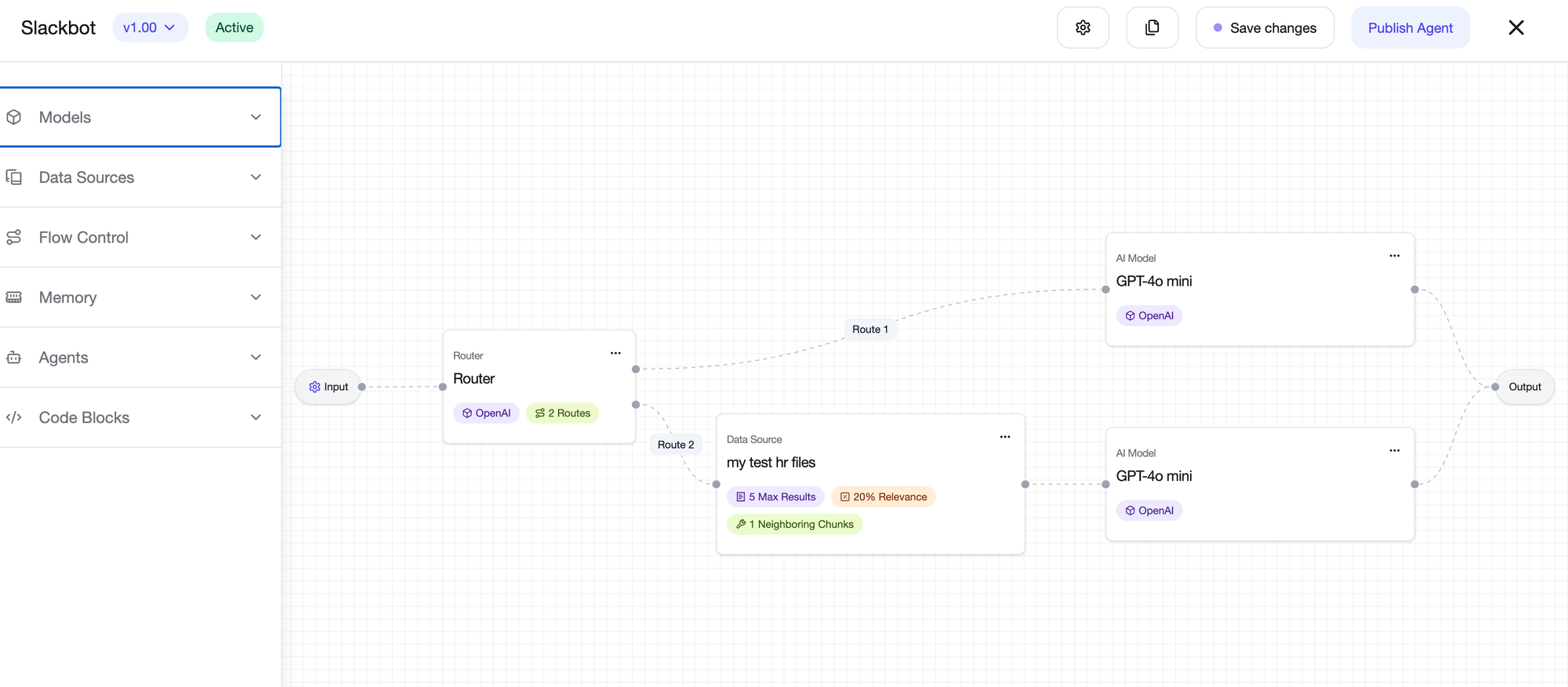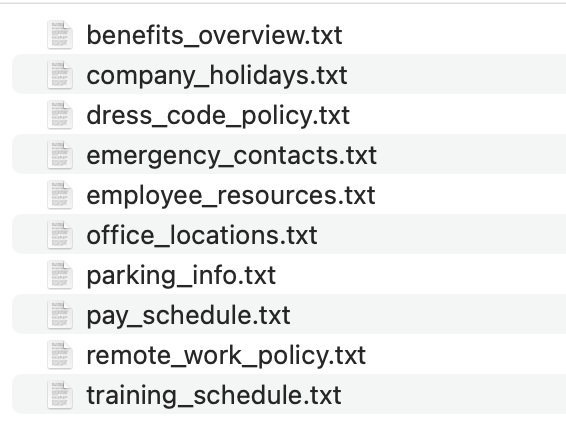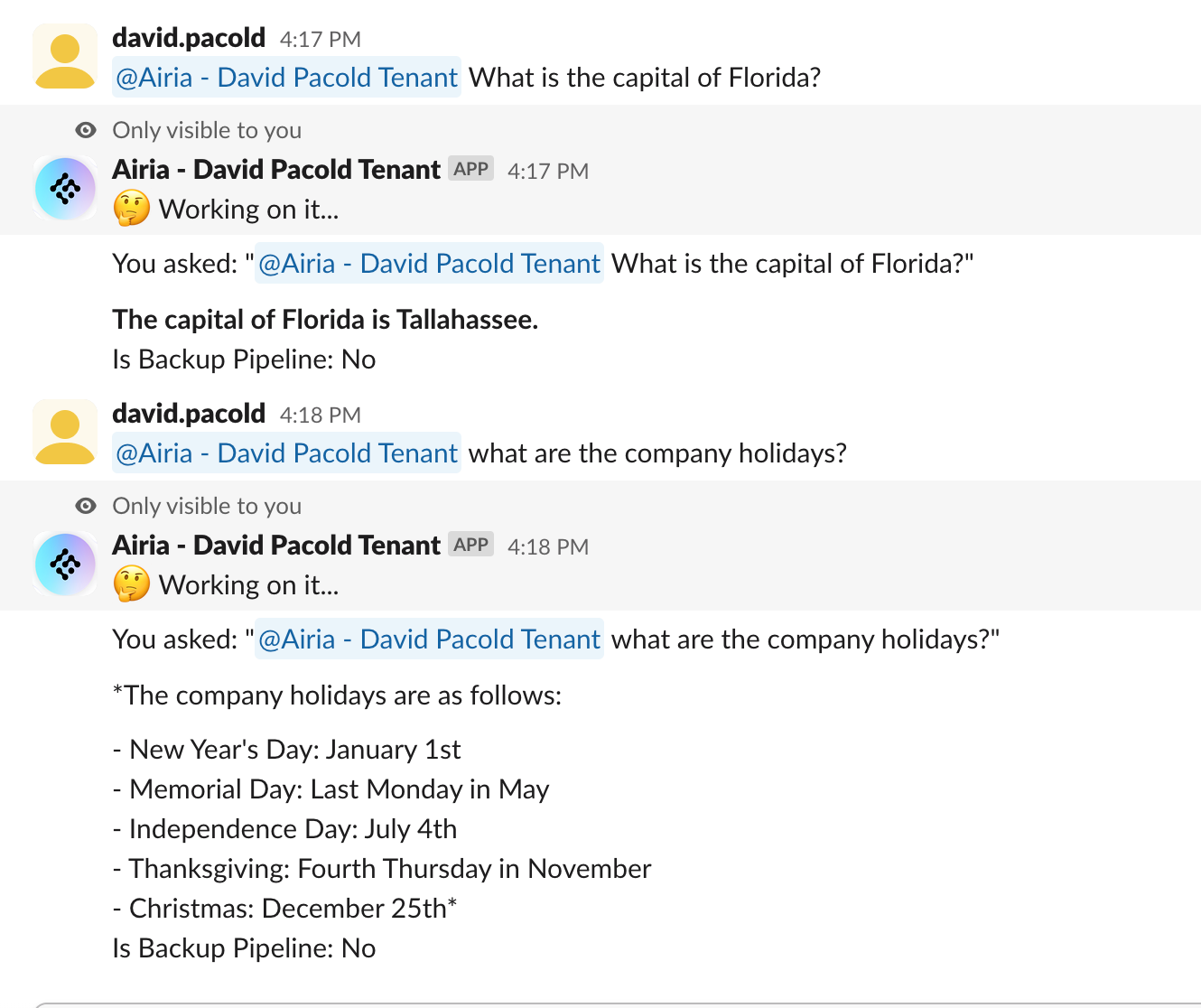Creating a Slack bot with Airia
As a new Solution engineer at Airia one of the things we do is a rotation though is managing our internal deployment of Airia and deploying new services to our colleagues.
Like many organizations we have a broad set of applications and services that are used across the company. This is a perfect deployment landscape for tools like Airia. While we offer a chat interface of our own where a user can go and use the Airia tool via chat, we also offer an API interface for any agent that is running in Airia.
In this post, we will set up an agent and build a slack app that any user in Slack can interact with and bring the Airia tools that much closer to them.
What we will be creating:

Our users will interact with the Agent in Slack via several methods, they can Direct Message the agent, @metnion the agent in a channel or use a slash command to send the agent a request. The Slack bot logic itself will be running and hosted in Cloudflare, using their Server-less Workers platform. As the users requests come in, the Slackbot service running in Cloudflare will call the Airia APIs. Airia will do its magic, mining data sources, making tool calls, interacting with a LLM to generate a reply to the user, and passing the response back though the chain to the user.
Lets get started!
Building a Flexible Slack Bot with Cloudflare & Airia
1. Introduction & Background
Many companies and developers look for a quick and reliable way to build Slack bots that handle direct messages (DMs), mentions, slash commands, and more. By combining Cloudflare Workers (for serverless edge code execution) with Airia (an AI-powered API for question/answer or advanced logic), you get:
- Scalable, Serverless – No servers to manage; pay-as-you-go usage.
- Powerful AI Responses – Airia’s backend can handle user queries, enabling dynamic or custom answers.
In this guide, you’ll set up a Slack bot that can:
- Respond to slash commands (e.g.,
/ask-airia) - Listen for @mentions in Slack channels
- Handle direct messages (DMs) from users
- Show a custom manual on the Slack Home tab
We’ll walk through every step — from configuring Slack to deploying your code on Cloudflare.
2. Set up an Airia AI Agent
We will be following the Airia platform documentation here: https://airia.com/explore/
- Login to the Airia Platform
- Create a new agent,since this will be a chatbot in Slack we will make it multipurpose. Our agent will look like the image below. You can see it starts with the users input, it will hit a router object, which will evaluate the users question and categorize it into a general knowledge category or a Human Resources Category type question.

Following the categorization of the question, it will either be handled by a genal purpose ChatGPT Model, or first be matched against a data set if an HR question.
Our HR dataset looks like this:

Should a user ask a question about benefits or holidays for example, the users question will be routed to the HR flow, relevant data pulled from the data source, and both the question and contextual data will be passed to the LLM.
In both cases, the LLM will them compose a response and reply to the user via Slack.
- With the agent published select the 3 dots on the same line as your agent and open "connection info"
4. Copy the API URL - Generate an Airia API key
6. From the left hand menu scroll down and select Settings
7. In the Airia API Keys menu, click create New
8. Give your API key a name and copy the Key value
You should have 2 pieces of information now, the API key and a API url of your slackbot agent.
3. Prerequisites
- Cloudflare Account with Workers enabled.
- Slack App: Created in the Slack API Dashboard.
- Airia API Access: An API key and endpoint from Airia.
- Node.js & Wrangler (optional but recommended for local development):
npm install -g wrangler
4. Slack App Manifest
Below is an example app manifest that you can use or adapt. It includes:
- Slash command (
/ask-airia) - Bot user with
app_mentionand direct message support - App home for a custom manual
display_information:
name: ask-airia
description: An Airia powered chatbot to ask your questions and get unstuck
background_color: '#000000'
features:
app_home:
home_tab_enabled: true
messages_tab_enabled: false
messages_tab_read_only_enabled: false
bot_user:
display_name: Ask Airia
always_online: false
slash_commands:
- command: /ask-airia
url: https://YOUR_WORKER_SUBDOMAIN.workers.dev/slack
description: Ask Airia a question
usage_hint: '[your question]'
should_escape: false
oauth_config:
scopes:
bot:
- app_mentions:read
- channels:history
- channels:read
- chat:write
- chat:write.public
- commands
- groups:read
- im:history
- im:write
- mpim:history
- mpim:read
- mpim:write
- users:read
settings:
event_subscriptions:
request_url: https://YOUR_WORKER_SUBDOMAIN.workers.dev/slack
bot_events:
- app_home_opened
- app_mention
- message.im
- message.mpim
interactivity:
is_enabled: true
request_url: https://YOUR_WORKER_SUBDOMAIN.workers.dev/slack
org_deploy_enabled: false
socket_mode_enabled: false
token_rotation_enabled: false
4. Cloudflare Worker Script
In the Github repo is a Cloudflare worker that can be used to deploy the Server functions to support the Slackbot.
The Cloudflare worker will:
- Verifies Slack signatures
- Handles
/ask-airiaslash commands - Updates the Home tab (
app_home_opened) - Responds to @mentions in channels
- Listens for direct messages (
message.im) - Prevents loops by ignoring bot’s own messages
Note: We store secrets like the Airia API key, Slack Signing Secret, and Slack Bot Token via Wrangler secrets. The endpoint (Airia API URL) can be a public environment variable if it’s not sensitive.
5. Deploying & Testing
-
Add Secrets
- You’ll need to store sensitive values (e.g., Slack Bot Token, Signing Secret, Airia API key) as Wrangler secrets:
wrangler secret put Slack_Bot_Token wrangler secret put Slack_Signing_Secret wrangler secret put Airia_API_key - If your Airia endpoint is non-sensitive, it can be a public environment variable in your
wrangler.tomlinstead of a secret.
- You’ll need to store sensitive values (e.g., Slack Bot Token, Signing Secret, Airia API key) as Wrangler secrets:
-
Publish the Worker
- Use Wrangler to deploy your Worker code to Cloudflare’s edge:
wrangler publish
- Use Wrangler to deploy your Worker code to Cloudflare’s edge:
-
Install/Reinstall Slack App
- If you changed scopes or events, reinstall the app so Slack updates your permissions.
- Confirm the following in your Slack App settings:
- Scopes (see Section 3 for the recommended list).
- Events:
app_home_opened,app_mention, andmessage.im. - Slash Command
/ask-airiais configured and points to your Worker URL.
- Click Install App to Workspace (or Reinstall if already installed).
-
Verify
- Home Tab: Open the Slack app’s Home tab. You should see the instructions/manual published by the Worker code.
- Slash Command: Try
/ask-airia What is the capital of Idaho?. Your Worker logs (viawrangler tail) should show the slash command request, and Slack should display a response from Airia. - @Mention: In any channel the bot is in, type
@ask-airia Hello!. The Worker logs should show anapp_mentionevent, and Slack should post the bot’s reply. - Direct Message: Open a DM with the bot and type a question. The logs should show a
message.imevent, and Slack should display the answer from Airia.
If any steps fail, confirm your Slack scopes, events, secrets, and that the Worker code is up to date with your endpoint references.
Lets test it out!
Here I have asked a general interest question followed by a question about our company specific holiday schedule:

6. Conclusion
By combining Cloudflare Workers (for globally distributed, serverless code) with Airia (for intelligent, AI-based responses), you can build a robust Slack bot that handles:
- Slash commands (
/ask-airia) - @mentions in channels
- Direct messages from users
- Home tab instructions/manual
This solution is both scalable (no servers to maintain) and flexible, letting you adapt the code to any AI logic or advanced API calls you want. With a few changes to your Slack settings and code deployment, you have a powerful, well-documented Slack app up and running in no time!
Happy building!
